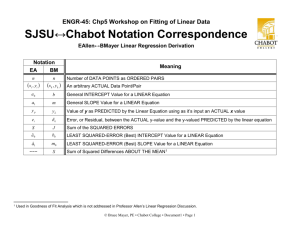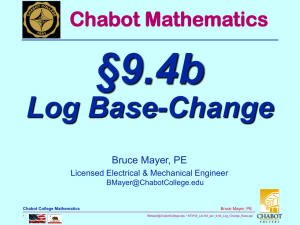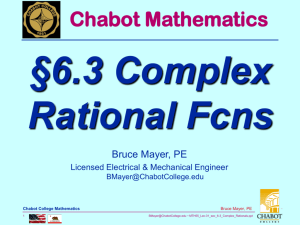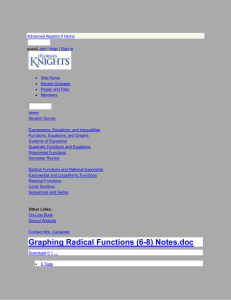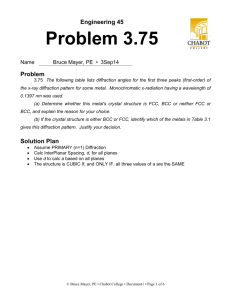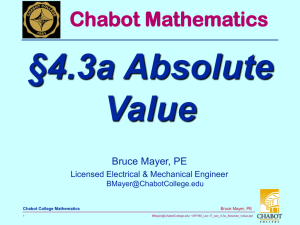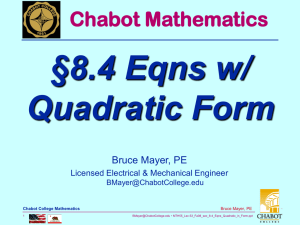MTH55_Lec-34_sec_6-6_Rational_Equations
advertisement
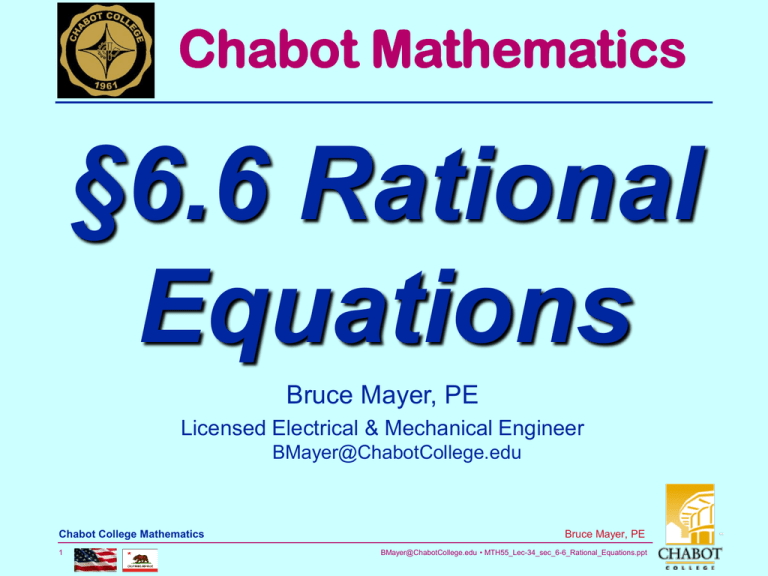
Chabot Mathematics §6.6 Rational Equations Bruce Mayer, PE Licensed Electrical & Mechanical Engineer BMayer@ChabotCollege.edu Chabot College Mathematics 1 Bruce Mayer, PE BMayer@ChabotCollege.edu • MTH55_Lec-34_sec_6-6_Rational_Equations.ppt Review § 6.4 MTH 55 Any QUESTIONS About • §6.4 → Complex Rational Expressions Any QUESTIONS About HomeWork • §6.4 → HW-26 Chabot College Mathematics 2 Bruce Mayer, PE BMayer@ChabotCollege.edu • MTH55_Lec-34_sec_6-6_Rational_Equations.ppt Solving Rational Equations In previous sections, we learned how to simplify expressions. We now learn to solve a new type of equation. A rational equation is an equation that contains one or more rational expressions. Some examples: 2x 7 x 5 8 6 2 5 8, 2 , x 4. 4x x x 3 x 3 x 9 x We want determine the value(s) for x that make these Equations TRUE Chabot College Mathematics 3 Bruce Mayer, PE BMayer@ChabotCollege.edu • MTH55_Lec-34_sec_6-6_Rational_Equations.ppt To Solve a Rational Equation 1. List any restrictions that exist. Numbers that make a denominator equal 0 canNOT possibly be solutions. 2. CLEAR the equation of FRACTIONS by multiplying both sides by the LCM of ALL the denominators present 3. Solve the resulting equation using the addition principle, the multiplication principle, and the Principle of Zero Products, as needed. 4. Check the possible solution(s) in the original equation. Chabot College Mathematics 4 Bruce Mayer, PE BMayer@ChabotCollege.edu • MTH55_Lec-34_sec_6-6_Rational_Equations.ppt Example Solve x x 1 5 2 4 SOLUTION - Because no variable appears in the denominator, no restrictions exist. The LCM of 5, 2, and 4 is 20, so we multiply both sides by 20 Using the multiplication principle x x 1 20 20 to multiply both sides by the LCM. Parentheses are important! 5 2 4 x x 1 Using the distributive law. 20 20 20 Be sure to multiply 5 2 4 EACH term by the LCM 4x 10x 5 Simplifying and solving for x. If 6x 5 fractions remain, we have either made a mistake or have not used 5 the LCM of ALL the denominators. x 6 Chabot College Mathematics 5 Bruce Mayer, PE BMayer@ChabotCollege.edu • MTH55_Lec-34_sec_6-6_Rational_Equations.ppt Checking Answers Since a variable expression could represent 0, multiplying both sides of an equation by a variable expression does NOT always produce an Equivalent Equation • COULD be Multiplying by Zero and Not Know it Thus checking each solution in the original equation is essential. Chabot College Mathematics 6 Bruce Mayer, PE BMayer@ChabotCollege.edu • MTH55_Lec-34_sec_6-6_Rational_Equations.ppt 1 1 4 Example Solve 3 x x 15 SOLUTION - Note that x canNOT equal 0. The Denominator LCM is 15x. 4 1 1 15 x 15 x 15 3x x 1 1 4 5 15x 15 x 15 x 3x x 15 5 15 4x 20 4x 5 x Chabot College Mathematics 7 Bruce Mayer, PE BMayer@ChabotCollege.edu • MTH55_Lec-34_sec_6-6_Rational_Equations.ppt Example Solve CHECK tentative Solution, x=5 The Solution x = 5 CHECKS Chabot College Mathematics 8 1 1 4 3 x x 15 1 1 4 3 x x 15 1 1 4 3(5) 5 15 1 1 4 15 5 15 1 3 4 15 15 15 4 4 15 15 Bruce Mayer, PE BMayer@ChabotCollege.edu • MTH55_Lec-34_sec_6-6_Rational_Equations.ppt Example Solve 12 x 7 x SOLUTION - Note that x canNOT equal 0. The Denom LCM is x 12 x x x(7) x 12 x x x 7x x x 2 12 7 x x 2 7 x 12 0 Thus by Zero Products: x=3 or x=4 ( x 3)( x 4) 0 ( x 3) 0 or ( x 4) 0 Chabot College Mathematics 9 Bruce Mayer, PE BMayer@ChabotCollege.edu • MTH55_Lec-34_sec_6-6_Rational_Equations.ppt Example Solve CHK: For x = 3 12 x 7 x For x = 4 12 x 7 x 12 3 7 3 12 x 7 x 12 4 7 4 3 4 7 43 7 77 77 Both of these check, so there are two solutions; 3 and 4 Chabot College Mathematics 10 Bruce Mayer, PE BMayer@ChabotCollege.edu • MTH55_Lec-34_sec_6-6_Rational_Equations.ppt Example Solve 5 3 2 2 y 9 y 3 y 3 SOLUTION Note that y canNOT equal 3 or −3. We multiply both sides of the equation by the Denom LCM. 3 5 2 ( y 3)( y 3) ( y 3)( y 3) ( y 3)( y 3) y 3 y 3 ( y 3 )( y 3 )5 ( y 3 )( y 3)3 ( y 3)( y 3 )2 ( y 3 )( y 3 ) y 3 y 3 5 3( y 3) 2( y 3) 5 y 15 5 3y 9 2 y 6 20 y Chabot College Mathematics 11 Bruce Mayer, PE BMayer@ChabotCollege.edu • MTH55_Lec-34_sec_6-6_Rational_Equations.ppt Example Solve 2 5 4 x 1 x 1 x 1x 1 SOLUTION - Note that x canNOT equal 1 or −1. Multiply both sides of the eqn by the LCM 5 4 2 ( x 1)( x 1) ( x 1)( x 1) x 1 x 1 ( x 1)( x 1) 2( x 1) 5( x 1) 4 2 x 2 5x 5 4 3x 7 4 3x 3 x 1 Chabot College Mathematics 12 Because of the restriction above, 1 must be rejected as a solution. This equation has NO solution. Bruce Mayer, PE BMayer@ChabotCollege.edu • MTH55_Lec-34_sec_6-6_Rational_Equations.ppt Example Solve 2x 7 x 5 8. 4x x SOLUTION: Because the left side of this equation is undefined when x is 0, we state at the outset that x 0. Next, we multiply both sides of the equation by the LCD, 4x: 2x 7 x 5 4x 4x 8 x 4x Chabot College Mathematics 13 Multiplying by the LCD to clear fractions Bruce Mayer, PE BMayer@ChabotCollege.edu • MTH55_Lec-34_sec_6-6_Rational_Equations.ppt Example Solve 2x 7 x 5 8. 4x x SOLN cont. 2x 7 x5 4x 4x 4x 8 4x x Using the distributive law 4 x(2 x 7) 4 x( x 5) 32 x 4x x Locating factors equal to 1 (2 x 7) 4( x 5) 32 x Removing factors equal to 1 2x 7 4x 20 32x Chabot College Mathematics 14 Using the distributive law Bruce Mayer, PE BMayer@ChabotCollege.edu • MTH55_Lec-34_sec_6-6_Rational_Equations.ppt Example Solve SOLN cont. 6x 13 32x 13 26x 1 2 CHECK 2x 7 x 5 8. 4x x x This should check since x 0. 2x 7 x 5 8 4x x 2 12 7 12 5 1 1 4 2 2 8 3 11 Chabot College Mathematics 15 88 Bruce Mayer, PE BMayer@ChabotCollege.edu • MTH55_Lec-34_sec_6-6_Rational_Equations.ppt Rational Eqn CAUTION When solving rational equations, be sure to list any restrictions as part of the first step. Refer to the restriction(s) as you proceed Chabot College Mathematics 16 Bruce Mayer, PE BMayer@ChabotCollege.edu • MTH55_Lec-34_sec_6-6_Rational_Equations.ppt Example Solve 8 6 2 2 . x 3 x 3 x 9 SOLUTION: To find all restrictions and to assist in finding the LCD, we factor: 8 6 2 . x 3 x 3 ( x 3)( x 3) Note that to prevent division by zero x 3 and x −3. Next multiply by the LCD, (x + 3)(x – 3), and then use the distributive law Chabot College Mathematics 17 Bruce Mayer, PE BMayer@ChabotCollege.edu • MTH55_Lec-34_sec_6-6_Rational_Equations.ppt Example Solve 8 6 2 2 . x 3 x 3 x 9 SOLUTION: By LCD Multiplication 6 2 8 ( x 3)( x 3) ( x 3)( x 3) ( x 3)( x 3) x 3 x 3 8 6 ( x 3)( x 3)2 ( x 3)( x 3) ( x 3)( x 3) x3 x 3 ( x 3)( x 3) Remove factors Equal to One and solve the resulting Eqn • Keep in Mind any restrictions Chabot College Mathematics 18 Bruce Mayer, PE BMayer@ChabotCollege.edu • MTH55_Lec-34_sec_6-6_Rational_Equations.ppt Example Solve SOLN cont.: Multiply and Collect Similar terms 8 6 2 2 . x 3 x 3 x 9 8( x 3) 6( x 3) 2 8x 24 6x 18 2 2x 42 2 2x 44 x 22 A check will confirm that 22 is the solution Chabot College Mathematics 19 Bruce Mayer, PE BMayer@ChabotCollege.edu • MTH55_Lec-34_sec_6-6_Rational_Equations.ppt Example Eqn with NO Soln Solve 3 x–1 – 2 x+1 = 6 . x2 – 1 Multiply each side by LCD, (x –1)(x + 1). To avoid division bythe zero, exclude from the expression domain 1 and –1, since these values make one or2more of the denominators 6 in the 3 – (x – 1)(x + 1) = (x – 1)(x + 1) 2 equation equal 0. x–1 x+1 x –1 (x – 1)(x + 1) 3 x–1 Chabot College Mathematics 20 – (x – 1)(x + 1) 3(x + 1) – 3x + 3 – 2 x+1 = (x – 1)(x + 1) 6 x2 – 1 2(x – 1) = property 6 Multiply. Distributive 2x + 2 = 6 Distributive property x+5 = 6 Combine terms. x = 1 Subtract 5. Bruce Mayer, PE BMayer@ChabotCollege.edu • MTH55_Lec-34_sec_6-6_Rational_Equations.ppt Example Eqn with NO Soln Solve 3 x–1 – 2 x+1 = 6 . x2 – 1 Since 1 is not in the domain, it cannot be a solution of the equation. Substituting 1 in the original equation shows why. Check: 3 x–1 – 2 x+1 = 6 x2 – 1 3 1–1 – 2 1+1 = 6 12 – 1 3 0 – 2 2 = 6 0 Since division by 0 is undefined, the given equation has no solution, and the solution set is ∅. Chabot College Mathematics 21 Bruce Mayer, PE BMayer@ChabotCollege.edu • MTH55_Lec-34_sec_6-6_Rational_Equations.ppt Example Fcn to Eqn 5 Given Function: f ( x) x . x Find all values of a for which f (a) 4. SOLUTION On Board 5 By Function Notation: f (a) a a Thus Need to find all values of a for which f(a) = 4 5 a 4. a Chabot College Mathematics 22 Bruce Mayer, PE BMayer@ChabotCollege.edu • MTH55_Lec-34_sec_6-6_Rational_Equations.ppt Example Fcn to Eqn 5 Solve for a: a 4. a First note that a 0. To solve for a, multiply both sides of the equation by the LCD, a: 5 aa 4a a Multiplying both sides by a. Parentheses are important. 5 a a a 4a Using the distributive law a Chabot College Mathematics 23 Bruce Mayer, PE BMayer@ChabotCollege.edu • MTH55_Lec-34_sec_6-6_Rational_Equations.ppt Example Fcn to Eqn CarryOut Solution CHECK a 2 5 4a a 2 4a 5 0 Simplifying Getting 0 on one side (a 5)(a 1) 0 Factoring a 5 or Using the principle of zero products a 1 5 5 1 4; 5 5 f (1) 1 1 5 4. 1 f (5) 5 STATE: The solutions are 5 and −1. For a = 5 or a = −1, we have f(a) = 4. Chabot College Mathematics 24 Bruce Mayer, PE BMayer@ChabotCollege.edu • MTH55_Lec-34_sec_6-6_Rational_Equations.ppt Rational Equations and Graphs One way to visualize the solution to the last example is to make a graph. This can be done by graphing; e.g., Given 5 f ( x) x . x Find x such that f(x) = 4 Chabot College Mathematics 25 Bruce Mayer, PE BMayer@ChabotCollege.edu • MTH55_Lec-34_sec_6-6_Rational_Equations.ppt Rational Equations and Graphs Graph the function, and on the same grid graph y = g(x) = 4 y y4 4 x -1 5 5 f ( x) x x We then inspect the graph for any x-values that are paired with 4. It appears from the graph that f(x) = 4 when x = 5 or x = −1. Chabot College Mathematics 26 Bruce Mayer, PE BMayer@ChabotCollege.edu • MTH55_Lec-34_sec_6-6_Rational_Equations.ppt Rational Equations and Graphs Graphing gives approximate solutions Although making a graph is not the fastest or most precise method of solving a rational equation, it provides visualization and is useful when problems are too difficult to solve algebraically Chabot College Mathematics 27 Bruce Mayer, PE BMayer@ChabotCollege.edu • MTH55_Lec-34_sec_6-6_Rational_Equations.ppt WhiteBoard Work Problems From §6.6 Exercise Set • 34, 38, 62 Rational Expressions Chabot College Mathematics 28 Bruce Mayer, PE BMayer@ChabotCollege.edu • MTH55_Lec-34_sec_6-6_Rational_Equations.ppt All Done for Today Remember: can NOT Divide by ZERO Chabot College Mathematics 29 Bruce Mayer, PE BMayer@ChabotCollege.edu • MTH55_Lec-34_sec_6-6_Rational_Equations.ppt Chabot Mathematics Appendix r s r s r s 2 2 Bruce Mayer, PE Licensed Electrical & Mechanical Engineer BMayer@ChabotCollege.edu – Chabot College Mathematics 30 Bruce Mayer, PE BMayer@ChabotCollege.edu • MTH55_Lec-34_sec_6-6_Rational_Equations.ppt Graph y = |x| 6 Make T-table x -6 -5 -4 -3 -2 -1 0 1 2 3 4 5 6 Chabot College Mathematics 31 5 y = |x | 6 5 4 3 2 1 0 1 2 3 4 5 6 y 4 3 2 1 x 0 -6 -5 -4 -3 -2 -1 0 1 2 3 -1 -2 -3 -4 -5 file =XY_Plot_0211.xls -6 Bruce Mayer, PE BMayer@ChabotCollege.edu • MTH55_Lec-34_sec_6-6_Rational_Equations.ppt 4 5 6 y 5 2 y 1 x 4 0 -6 -5 -4 -3 -2 -1 3 0 1 2 3 4 -1 -2 2 -3 1 -4 x -5 5 -6 0 -3 -2 -1 0 1 2 3 -1 4 -7 -8 -2 -9 M55_§JBerland_Graphs_0806.xls -3 Chabot College Mathematics 32 file =XY_Plot_0211.xls -10 Bruce Mayer, PE BMayer@ChabotCollege.edu • MTH55_Lec-34_sec_6-6_Rational_Equations.ppt 5 6
